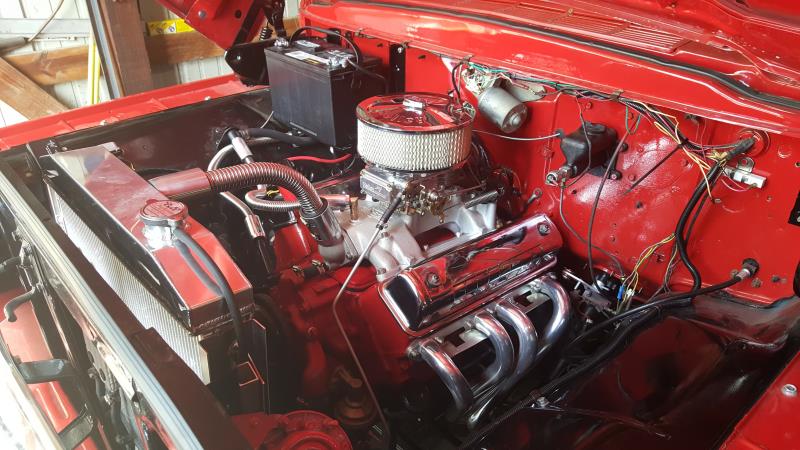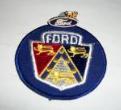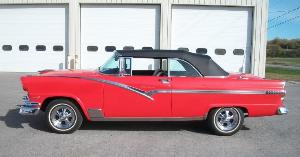|
Author
|
Message
|
|
CoryHoward
|
|
Hitting on all eight cylinders
Group: Forum Members
Last Active: 8 Years Ago
Posts: 7,
Visits: 40
|
Not only am I new to this forum, but I am also new to working on old vehicles, let alone a Y-block. Some back story of my truck. Before my father passed a few years ago, he started the restoration of his '59 F-100 with a 292. He took the motor to a local engine shop and had them do a complete rebuild of the block and heads. From what I know, ha had them replace all the original internals with new of the same spec. The only thing I do know is that he had them put in a "mild" cam, but I don't have the specs on it right now. When he got the engibe back, he replaced the old 2 brl intake and carb for a stock "A" code 4 brl intake and a Holley 600 cfm (I know its bigger then needed but it's what dad bought) and installed a set of headers. The only thing that has been changed since this is I installed a Mummert aluminum intake and my brother switched it over to electronic ignition. We are trying to put the finishing touches on the truck and have ran into a fairly big issue in regards to the timing. We tried setting the initial timing using vacuum first but could only manage to get about 12 on the gauge at idle (@650 rpm). When we put the timing light on it to check where we were, it was about 42° advance. We know that this is way off, but are struggling to figure out why. We verrified TDC for #1 cylinder and checked the rotor position on the distributor and it was good, so we are pretty sure the distributor is in correctly. I know very little about distributors but the rotor seemed very loose. I am not sure how much rotational play there should be in the rotor. I also know that the cam timing is set on this engine using the 3 'oclock method with 12 pins between the marks. I think that if this was off, the engine would not run at all so I am pretty sure this was done correctly also. I don't know anything about switching to electronic ignition, but is there anything that could ave been done wrong? It appears that the original distributor body was used in the switch. I assume I have a lot of missing info to figure out what is going on, but hoping there are some Y-Block gurus out there that can point me in the right direction. Any and all assistance is greatly appreciated. 
|
|
|
|
|
Dobie
|
|
|
Group: Forum Members
Last Active: 2 Years Ago
Posts: 476,
Visits: 22.0K
|
Is the timing pointer pointing to TDC when you have no. 1 piston at TDC on the compression stroke? If not your damper may have slipped, y-blocks are notorious for it when the damper gets some age on it. Your brother probably used a Pertronix, Accel or some other drop-in electronic ignition conversion. The fact that it runs says he did it right. Have a look at the damper with a bright light and an inspection mirror. If the rubber between the crank pulley and the outer ring is deteriorated that's probably the problem. Nobody makes new ones but the Damper Doctor and the Damper Dudes have rebuilt ones on an exchange basis, or they will rebuild yours.
|
|
|
|
|
CoryHoward
|
|
Hitting on all eight cylinders
Group: Forum Members
Last Active: 8 Years Ago
Posts: 7,
Visits: 40
|
Thats what I am leaning towards. I need to find a way to actually verify that #1 is true TDC without removing the head. We just bumpend engine until we could feel the compression building then just used the marks. If the rubber has slipped, then we are not actually on TDC on #1. I hope it is this simple. If not then we have a bigger issue that may require us to pull the engine.
|
|
|
|
|
Gene Purser
|
|
|
Group: Forum Members
Last Active: 4 Years Ago
Posts: 220,
Visits: 6.0K
|
I had similar cam timing concern with an engine I have that was rebuilt by someone else. This post helped me be reasonably sure that my cam and TDC mark were correct. Carburetor adjustment also plays a part in good vacuum, as does valve adjustment. And vacuum will probably improve some with engine break-in. https://www.fordbarn.com/forum/showthread.php?t=223428With the distributor pointing to the # 6 firing position the valves on #1 cylinder are at an equal overlap position and the pointer will be approximately at the TDC mark if everything is as it should be. Use a socket to turn the engine until a strait edge is level across the valve retainers on # 1 cylinder.
|
|
|
|
|
oldcarmark
|
|
|
Group: Forum Members
Last Active: Last Month
Posts: 3.7K,
Visits: 32.6K
|
CoryHoward (7/9/2017)
Not only am I new to this forum, but I am also new to working on old vehicles, let alone a Y-block. Some back story of my truck. Before my father passed a few years ago, he started the restoration of his '59 F-100 with a 292. He took the motor to a local engine shop and had them do a complete rebuild of the block and heads. From what I know, ha had them replace all the original internals with new of the same spec. The only thing I do know is that he had them put in a "mild" cam, but I don't have the specs on it right now. When he got the engibe back, he replaced the old 2 brl intake and carb for a stock "A" code 4 brl intake and a Holley 600 cfm (I know its bigger then needed but it's what dad bought) and installed a set of headers. The only thing that has been changed since this is I installed a Mummert aluminum intake and my brother switched it over to electronic ignition. We are trying to put the finishing touches on the truck and have ran into a fairly big issue in regards to the timing. We tried setting the initial timing using vacuum first but could only manage to get about 12 on the gauge at idle (@650 rpm). When we put the timing light on it to check where we were, it was about 42° advance. We know that this is way off, but are struggling to figure out why. We verrified TDC for #1 cylinder and checked the rotor position on the distributor and it was good, so we are pretty sure the distributor is in correctly. I know very little about distributors but the rotor seemed very loose. I am not sure how much rotational play there should be in the rotor. I also know that the cam timing is set on this engine using the 3 'oclock method with 12 pins between the marks. I think that if this was off, the engine would not run at all so I am pretty sure this was done correctly also. I don't know anything about switching to electronic ignition, but is there anything that could ave been done wrong? It appears that the original distributor body was used in the switch. I assume I have a lot of missing info to figure out what is going on, but hoping there are some Y-Block gurus out there that can point me in the right direction. Any and all assistance is greatly appreciated.  Not sure I understand your Reference to the Rotor being "Loose". The Rotor should be tight on the Distributor Shaft and not move at all.Is the Rotor in good Shape inside? It should fit Tight with the Slot in the Distributor Shaft.
 
|
|
|
|
|
CoryHoward
|
|
Hitting on all eight cylinders
Group: Forum Members
Last Active: 8 Years Ago
Posts: 7,
Visits: 40
|
Mark, the rotor is brand new. I didn't think it should move on the distributor shaft but infact rotates quite a bit with ease. Gonna have to see why it is loose.
|
|
|
|
|
57RancheroJim
|
|
|
Group: Forum Members
Last Active: Last Year
Posts: 729,
Visits: 112.0K
|
Are you sure the rotor is loose? The rotor may appear to being loose but it will rotate a little, the shaft is also rotating with it, you may be feeling the mechanical advance. It will only rotate in one direction and when let loose it should spring back to the original position.
|
|
|
|
|
CoryHoward
|
|
Hitting on all eight cylinders
Group: Forum Members
Last Active: 8 Years Ago
Posts: 7,
Visits: 40
|
Jim, I will check to see if it springs back. Due to the truck being at my parents house, I won't be able to check it until this weekend. If it doesn't spring back that tells me the mechanical advance is bad right?
|
|
|
|
|
charliemccraney
|
|
|
Group: Moderators
Last Active: Yesterday
Posts: 6.1K,
Visits: 442.8K
|
You probably have a combination of problems. It doesn't have 42 degrees of initial timing. The engine simply would not turn over if it did. Your method to set initial is not correct. It is not vacuum that you use to set timing. You set it with a timing light. You also need to be sure that the vacuum advance is disconnected and the vacuum port plugged when setting timing. If you do not, it will add timing to the engine, making it appear to have more than it actually has. Another reason you might see higher than actual timing is that the damping mass has slipped. That is the part with the timing marks on it. If the damper is original or an old rebuild, then that is high on the list.
Lawrenceville, GA
|
|
|
|
|
oldcarmark
|
|
|
Group: Forum Members
Last Active: Last Month
Posts: 3.7K,
Visits: 32.6K
|
charliemccraney (7/11/2017)
You probably have a combination of problems. It doesn't have 42 degrees of initial timing. The engine simply would not turn over if it did. Your method to set initial is not correct. It is not vacuum that you use to set timing. You set it with a timing light. You also need to be sure that the vacuum advance is disconnected and the vacuum port plugged when setting timing. If you do not, it will add timing to the engine, making it appear to have more than it actually has. Another reason you might see higher than actual timing is that the damping mass has slipped. That is the part with the timing marks on it. If the damper is original or an old rebuild, then that is high on the list. Old Time Mechanics would often set Timing using a Vacuum Gauge. Simply advance the Distributor to get Highest Vacuum reading and then turn back until vacuum starts to drop. Set Distributor half way between highest and lowest. If it knocks under load back Timing back until it stops. O
 
|
|
|
|